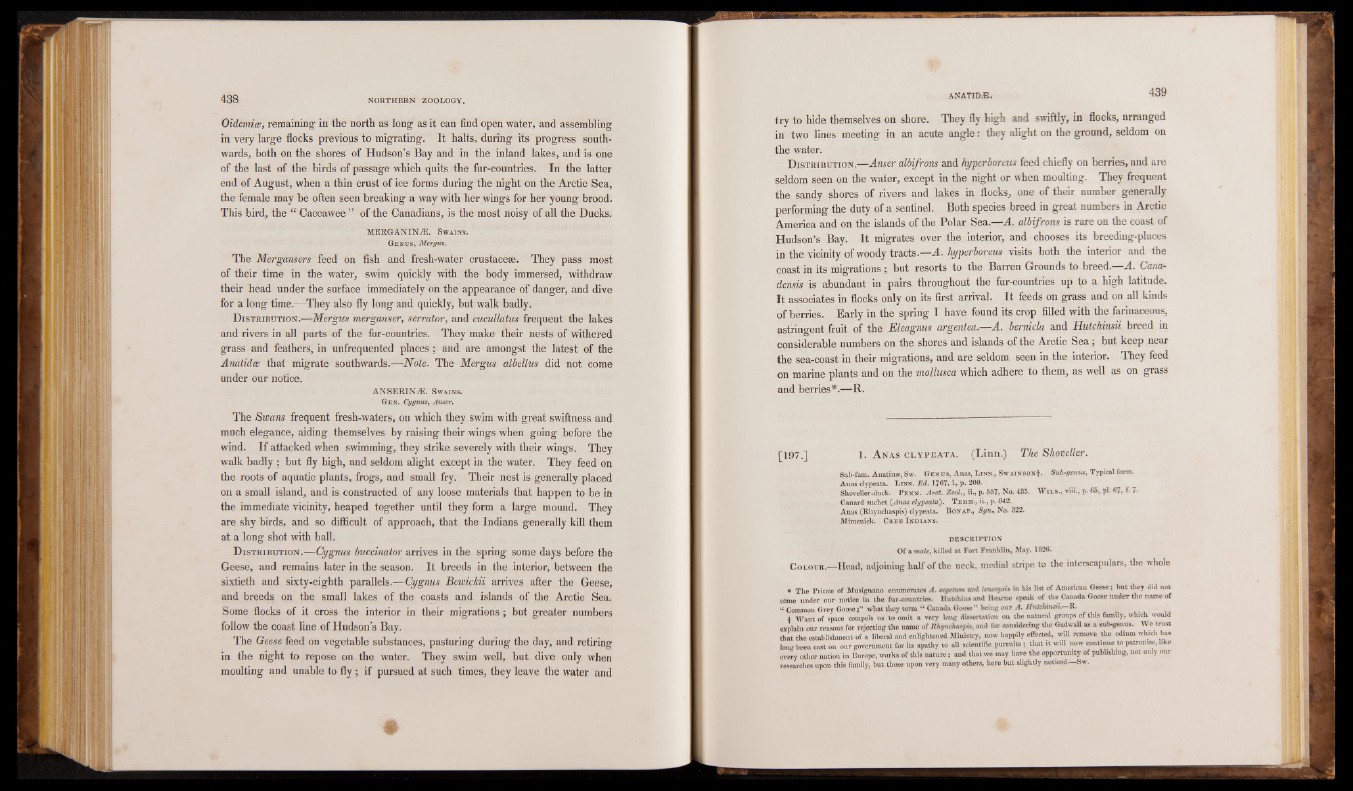
OidemiiE, remaining in the north as long as it can find open water, and assembling
in very large flocks previous to migrating. It halts, during its progress southwards,
both on the shores of Hudson’s Bay and in the inland lakes, and is one
of the last of the birds of passage which quits the fur-countries. In the latter
end of August, when a thin crust of ice forms during the night on the Arctic Sea,
the female may be often seen breaking a way with her wings for her young brood.
This bird, the “ Caccawee ” of the Canadians, is the most noisy of all the Ducks.
MERGANINiE. Swains..
Genus, Mergus. The Mergansers feed on fish and fresh-water crustaeese. They pass most
of their time in the water, swim quickly with the body immersed, withdraw
their head under the surface immediately on the appearance of danger, and dive
for a long time. -They also fly long and quickly, but walk badly.
Distribution.—Mergus merganser, serrator, and cucullatus frequent the lakes
and rivers in all parts of the fur-countries. They make their nests of withered
grass and feathers, in unfrequented places ; and are amongst the latest of the
Anatidw that migrate southwards.—Note. The Mergus albellus did not come
under our notice.
ANSERINE. Swains,
Gen. Cygnus, Anser.
The Swans frequent fresh-waters, on which they swim with great swiftness and
much elegance, aiding themselves by raising their wings when going before the
wind. If attacked when swimming, they strike severely with their wings. They
walk badly; but fly high, and seldom alight except in the water. They feed on
the roots of aquatic plants, frogs, and small fry. Their nest is generally placed
on a small island, and is constructed of any loose materials that happen to be in
the immediate vicinity, heaped together until they form a large mound. They
are shy birds, and so difficult of approach, that the Indians generally kill them
at a long shot with ball.
Distribution.—Cygnus buccinator arrives in the spring some days before the
Geese, and remains later in the season. It breeds in the interior, between the
sixtieth and sixty-eighth parallels.-—Cygnus Bewicldi arrives after the Geese,
and breeds, on the small lakes of the coasts and islands of the Arctic Sea.
Some flocks of it cross the interior in their migrations; but greater numbers
follow the coast line of Hudson’s Bay.
The Geese feed on vegetable substances, pasturing during the day, and retiring
in the night to repose on the water. They swim well, but dive only when
moulting and unable to fly; if pursued at such times, they leave the water and
try to hide themselves on shore. They fly high and swiftly, in flocks, arranged
in two lines meeting in an acute angle: they alight on the ground, seldom on
theD water. istribution.—Anser albifrons and kyperboreus feed chiefly on berries, and are
seldom seen on the water, except in the night or when moulting. They frequent
the sandy shores of rivers and lakes in flocks, one of their number generally
performing the duty of a sentinel. Both species breed in great numbers in Arctic
America and on the islands of the Polar Sea.—A. albifrons is rare on the coast of
Hudson’s Bay. It migrates over the interior, and chooses its breeding-places
in the vicinity of woody tracts.—A . kyperboreus visits both the interior and the
coast in its migrations; but resorts to the Barren Grounds to breed. A . Cana~
densis is abundant in pairs throughout the fur-countries up to a high latitude.
It associates in flocks only on its first arrival. It feeds on grass and on all kinds
of berries. Early in the spring I have found its crop filled with the farinaceous,
astringent fruit of the Eleagnus argentea.—A . bemicla and Hutchinsii breed in
considerable numbers on the shores and islands of the Arctic Sea; but keep near
the sea-coast in their migrations, and are seldom seen in the interior. They feed
on marine plants and on the mollusca which adhere to them, as well as on grass
and berries*.—R.
[197.] 1. A nas c l y p e a t a . (Linn.) The Shoveller.
Sub-fam. Anatinae, Sw. Genus, Anas, Linn., Swainson|. Sttb-genus, Typical form.
Anas clypeata. Linn. Ed. 1767. i., p. 200.
Shoveller-duck. P enn. Arot. ZooL, ii., p. 557, No. 485. Wils., viii., p. 65, pi. 67, f- 7-
Canard suchet (Anas clypeata). Temm., ii., p. 842.
Anas (Rhynchaspis) clypeata. Bonap., Syn., No. 322.
Mimenick. Cb.ee Indians.
DESCRIPTION
Of a male, killed at Fort Franklin, May, 1826.
Colour.—Head, adjoining half of the neck, medial stripe to the interscapulars, the whole
• The Prince of Musignano enumerates .1. segehm and Ittieopsis in his list of American Geese; hut they did not
come under our notice in the fur-conntries. Hutchins and Hearne speak of the Canada Goose under the name of
“ Common Grey G oosew hat they term “ Canada Goose*’ being our A. Rutchinsu — R.
| Want of space compels us to omit a very long dissertation on the natural groups of this family, which would
explain our reasons for rejecting the name of Ehynehasph, and for considering the Gadwall as a submenus. We trust
that the establishment of a liberal and enlightened Ministry, now happily effected, will remove the odium which has
long been cast on our government for its apathy to all scientific pursuits; that it will now continue to patronise, like
every other nation in Europe, works of this nature; and that we may have the opportunity of publishing, not only our
researches upon this family, but those upon very many others, here but slightly noticed.—Sw.